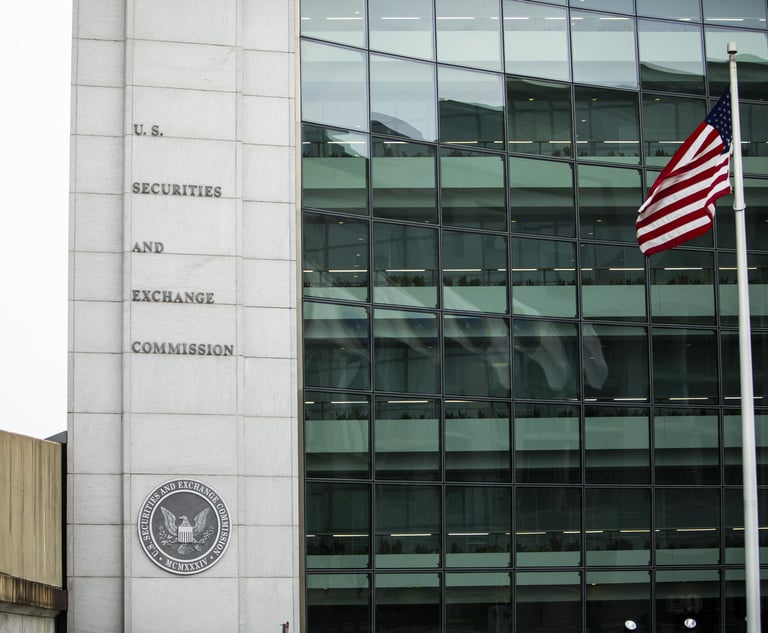Volatility Abounds in Large Law Firm Growth
The largest law firms appear to be getting smarter about what sizes they want to be. In a world where size and growth is a near-obsession at some of the country's largest firms, many have continued to grow at a rate that's more volatile than what the average nationwide statistics suggest. And inversely, some of the biggest firms have decreased their footprints in a noticeable way.
June 26, 2017 at 11:53 AM
5 minute read
 (Credit: Rawpixel.com/Shutterstock.com)
(Credit: Rawpixel.com/Shutterstock.com) The largest law firms appear to be getting smarter about what sizes they want to be.
In a world where size and growth is a near-obsession at some of the country's largest firms, many have continued to grow at a rate that's more volatile than what the average nationwide statistics suggest. And inversely, some of the biggest firms have decreased their footprints in a noticeable way.
That amount of movement isn't always captured in industry averages. Overall, the number of lawyers last year who work at the country's largest 500 law firms increased by about 2 percent, to 163,700. The average firm size was 327 lawyers, up a hair from 320 the year before.
In comparison, only a handful of firms among the 20 largest on our list changed their size by fewer than 2 percent plus or minus.
 Law firm consultant Miriam Herman, who regularly advises major firms on global growth, called the phenomenon “continuous recalibration.”
Law firm consultant Miriam Herman, who regularly advises major firms on global growth, called the phenomenon “continuous recalibration.”
“Savvy firms will be adding and shedding consistent with a strategy geared to the particulars of their practice, client and geographic strengths,” she added.
Baker McKenzie, the largest U.S.-centered law firm in the NLJ 500, grew almost 6 percent. That change in size came without the firm completing a merger or opening a new office.
DLA Piper, the second largest firm in the survey, declined in head count by 4 percent, even in a year it acquired three small firms, in Sweden, Finland and Canada.
In the two greatest swings among the 20 largest firms, Lewis Brisbois Bisgaard & Smith grew by almost 12 percent, while Reed Smith shrank by more than 5 percent. (Dentons, whose leadership is primarily based in the United States and which claims to be the world's largest firm, is not included in the NLJ 500 survey because it counts more lawyers in China than in the U.S.)
Michael Wagner, Baker McKenzie's chair for North America, said that programs at his firm that focus more on client relationships and feedback — plus emphases on certain industries — allow for more targeted lawyers to come aboard.
At the geographic level, Baker McKenzie added the most lawyers to its São Paulo office last year, for an addition of 50, or more than 30 percent growth. The office now has almost 200 lawyers. Wagner noted how the firm is leading compliance and investigations work for several clients in Brazil, previously including JBS SA, a meat processing company facing a bribery investigation.
“No one wants to slip in their market ranking. [But] our focus is on the clients, not on the prestige, not on the reach and so forth,” Wagner said. “We're just targeting our investments to things clients tell us in the market to do.”
Roger Meltzer, global co-chairman of DLA Piper, called his firm's loss of lawyers in 2016 a “result of natural attrition and the constant reshaping of our professional workforce.”
Even the firm Jackson Walker — which with 347 lawyers and 2.8 percent growth last year, making it a quintessentially average firm in our survey — has taken on a nuanced approach to firm size.
“We continue to believe we're in a slice of the market where we can continue to grow,” said Wade Cooper, managing partner of the Texas-based firm. “We don't have ambition to grow outside the state.”
Jackson Walker has made strategic plans twice since the recession, when all firms' annual growth rates largely abandoned a steady ascent. The firm decided it was comfortable being a regional firm, and could find laterals from both national practices and locally. Jackson Walker hopes to continue to grow, but Cooper said he's not interested in doing so the classic way, via merger.
This content has been archived. It is available through our partners, LexisNexis® and Bloomberg Law.
To view this content, please continue to their sites.
Not a Lexis Subscriber?
Subscribe Now
Not a Bloomberg Law Subscriber?
Subscribe Now
NOT FOR REPRINT
© 2025 ALM Global, LLC, All Rights Reserved. Request academic re-use from www.copyright.com. All other uses, submit a request to [email protected]. For more information visit Asset & Logo Licensing.
You Might Like
View All
Bankruptcy Judge Clears Path for Recovery in High-Profile Crypto Failure
3 minute read
Government Attorneys Face Reassignment, Rescinded Job Offers in First Days of Trump Administration
4 minute read
DC Judge Chutkan Allows Jenner's $8M Unpaid Legal Fees Lawsuit to Proceed Against Sierra Leone
3 minute readTrending Stories
Who Got The Work
J. Brugh Lower of Gibbons has entered an appearance for industrial equipment supplier Devco Corporation in a pending trademark infringement lawsuit. The suit, accusing the defendant of selling knock-off Graco products, was filed Dec. 18 in New Jersey District Court by Rivkin Radler on behalf of Graco Inc. and Graco Minnesota. The case, assigned to U.S. District Judge Zahid N. Quraishi, is 3:24-cv-11294, Graco Inc. et al v. Devco Corporation.
Who Got The Work
Rebecca Maller-Stein and Kent A. Yalowitz of Arnold & Porter Kaye Scholer have entered their appearances for Hanaco Venture Capital and its executives, Lior Prosor and David Frankel, in a pending securities lawsuit. The action, filed on Dec. 24 in New York Southern District Court by Zell, Aron & Co. on behalf of Goldeneye Advisors, accuses the defendants of negligently and fraudulently managing the plaintiff's $1 million investment. The case, assigned to U.S. District Judge Vernon S. Broderick, is 1:24-cv-09918, Goldeneye Advisors, LLC v. Hanaco Venture Capital, Ltd. et al.
Who Got The Work
Attorneys from A&O Shearman has stepped in as defense counsel for Toronto-Dominion Bank and other defendants in a pending securities class action. The suit, filed Dec. 11 in New York Southern District Court by Bleichmar Fonti & Auld, accuses the defendants of concealing the bank's 'pervasive' deficiencies in regards to its compliance with the Bank Secrecy Act and the quality of its anti-money laundering controls. The case, assigned to U.S. District Judge Arun Subramanian, is 1:24-cv-09445, Gonzalez v. The Toronto-Dominion Bank et al.
Who Got The Work
Crown Castle International, a Pennsylvania company providing shared communications infrastructure, has turned to Luke D. Wolf of Gordon Rees Scully Mansukhani to fend off a pending breach-of-contract lawsuit. The court action, filed Nov. 25 in Michigan Eastern District Court by Hooper Hathaway PC on behalf of The Town Residences LLC, accuses Crown Castle of failing to transfer approximately $30,000 in utility payments from T-Mobile in breach of a roof-top lease and assignment agreement. The case, assigned to U.S. District Judge Susan K. Declercq, is 2:24-cv-13131, The Town Residences LLC v. T-Mobile US, Inc. et al.
Who Got The Work
Wilfred P. Coronato and Daniel M. Schwartz of McCarter & English have stepped in as defense counsel to Electrolux Home Products Inc. in a pending product liability lawsuit. The court action, filed Nov. 26 in New York Eastern District Court by Poulos Lopiccolo PC and Nagel Rice LLP on behalf of David Stern, alleges that the defendant's refrigerators’ drawers and shelving repeatedly break and fall apart within months after purchase. The case, assigned to U.S. District Judge Joan M. Azrack, is 2:24-cv-08204, Stern v. Electrolux Home Products, Inc.
Featured Firms
Law Offices of Gary Martin Hays & Associates, P.C.
(470) 294-1674
Law Offices of Mark E. Salomone
(857) 444-6468
Smith & Hassler
(713) 739-1250









